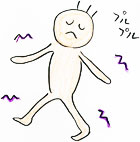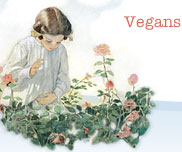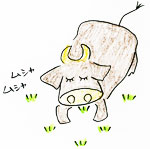|
The reason you feel that "meat is delicious!" is because of the full flavour of the fat in the meat, but the truth is that it is the fat that harms the body.
If you consume too much animal fat, cholesterol builds up in your blood vessels and will cause arteriosclerotic disease, leading to lifestyle-related diseases such as heart disorders, diabetes, cerebrovascular disorders. The US Public Health Service reports that 70% of disease-related deaths in the US are from lifestyle-related diseases caused by over-consumption of animal fats.
What is also increasing recently is the occurrence of cancer from the over-consumption of animal protein.
If animal protein builds up in the body, an essential amino acid, tryptophan, is decomposed by the bacteria in the intestines, promoting the production of carcinogenic substances or substances from which carcinogens may be synthesized.
(Research into the relation between increasing animal protein consumption and cancer have shown that the frequency of breast cancer is increased.)
It is also said that cancer may be promoted by the high iron content of meat. It does seems as if for several reasons meat consumption may be the cause of a wide range of diseases.
A report by a Canadian specialist also points out that meat consumption may promote the occurrence or development of cancer, and warns that such diseases may continue to increase unless there is a change in dietary habits towards the consumption of more vegetable protein foods such as vegetables and grains.
Mad Cow Disease comes from the eating of others!
|
<What is Mad Cow Disease?>
| Mad cow disease, first appearing in the UK in 1986, is a disease of the central nervous system of cattle involving spasms and paralysis, loss of weight, and walking disability until eventually the cow becomes unable to stand. There is no cure. |
<The cause of mad cow disease is prions, but what are they?>
| Prions are special proteins; they are non-living entities that can reproduce without having a nucleus.
They are very tough customers which do not die even if you boil them, burn them, or soak them in formalin!
|
|
|
|
Prion incubation period – 15-20 years |
Prions are proteins that control the activity of brain cells, and are usually produced in the bodies of humans and animals.
|
|
| For some reason abnormal prions have developed... |
|
|
|
|
| These change the normal prions one by one into abnormal prions, the abnormal prions accumulating in the brain, destroying brain cells. |
|
<Abnormal prions appear to be produced through the use of meat-and-bone meal mixed feed? >
|
|
Cattle are originally herbivores! So why...?
It appears that the cause is the meat-and-bone meal mixed feed that was given to the animals. This mixed feed consists of waste meat, organs, brains, and bones all minced up together, but with the fat removed. (Diseased meat also appears to have been mixed in with the feed.)
|
| These abnormal prions, never before known to exist in nature, appear to have been created as a result of this forced, artificial "cannibalism" through the use of mixed feed! |
<A human disease exactly like mad cow disease>
| Up until 1950, cannibalism existed among the Fore tribe of eastern Papua New Guinea |
 |
|
|
|
| Because of this, they suffered a disease called "kuru" which is very similar to mad cow disease!
If the disease appeared, the person became emotionally unstable, manic-depressive, had walking disorders, body shaking, total paralysis, and eventually died.
|
|
|
|
|
| Mad cow disease continues today.
Infection in humans, crossing the species barrier, also seems to be occurring.
This disease is called variant Creutzfeldt-Jacob Disease (vCJD).
|
|
|
What do humans eat?

It looks like we can say, from looking at the structure of the human body, that the kind of food we should be eating is probably grains, vegetables and fruit, in other words focussing on plant foods.
|
|












![Vegetarian Recipes [Japanese]](../images/contents01_a.gif)

![Vegetarian Recipes [Chinese]](../images/contents01_b.gif)

![Vegetarian Recipes [European ,etc]](../images/contents01_c.gif)

![Vegetarian Recipes [Sweets]](../images/contents01_d.gif)























![Vegetus Shop [Japanese]](../images/vegetesu_shop.jpg)

![Wakyo Co.,Ltd. [Japanese]](../images/wakyo.jpg)

![Vegetarian Therapy [Japanese]](../images/vegeterian_therapy.jpg)
























